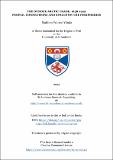Files in this item
The Dundee Arctic trade, 1858-1922 : people, connections and spaces on the peripheries
Item metadata
| dc.contributor.advisor | Struck, Bernhard | |
| dc.contributor.advisor | Easterby-Smith, Sarah | |
| dc.contributor.author | Ylitalo, Matthew Warren | |
| dc.coverage.spatial | 288 | en_US |
| dc.date.accessioned | 2023-04-13T09:18:00Z | |
| dc.date.available | 2023-04-13T09:18:00Z | |
| dc.date.issued | 2023-06-15 | |
| dc.identifier.uri | https://hdl.handle.net/10023/27394 | |
| dc.description.abstract | Existing whaling historiography frames the end of the traditional whaling era in the Arctic along established interpretational and methodological paradigms. These perspectives consider the industry almost entirely within the context of ships, men, whales and the sea. This thesis shifts its attention to the industry’s historical peripheries to examine the people, connections and spaces which existed within Dundee’s widening scope of Arctic commercial activities from 1858 to 1922. As bowhead whale populations diminished, the trade began to diversify its financial base of support, explore additional natural resource to exploit on an industrial scale, and change the dynamics of its labour requirements. Going beyond the men on whaling ships, the thesis seeks to identify what other people and activities defined this enterprise. Research therefore introduces the term ‘Arctic trade’ to comprehend its investigation into this transitive era more fully. The thesis adopts a transnational/global history approach, enabling it to shift from a national perspective to a changing mix of local, regional and transoceanic historical scales. This makes it possible for research to recognise the various social and spatial boundaries within the Arctic trade and study where they can be found. Research also considers the ways in which the industry became a variable social anchor within the transmaritime communities it engaged. | en_US |
| dc.description.sponsorship | "This work was supported through an Applied Research Collaborative Scholarship administered by the Scottish Graduate School for Arts and Humanities (SGSAH) from 1 October 2015 to 30 September 2018. Under the terms of the studentship agreement, financial support came from three institutions under one grant number. These were the Scottish Funding Council (50 per cent), University of St Andrews (25 per cent) and University of Dundee (25 per cent) [grant number AH/L503915/1]." --Funding | en |
| dc.language.iso | en | en_US |
| dc.relation | The Dundee Arctic Trade, 1858-1922: People, Connections and Places on the Peripheries (thesis data) Ylitalo, M. W., University of St Andrews, 12 Feb 2023. DOI: https://doi.org/10.17630/feec0aab-7588-4960-b3ec-507ce04adca4 | en |
| dc.relation.uri | https://doi.org/10.17630/feec0aab-7588-4960-b3ec-507ce04adca4 | |
| dc.rights | Creative Commons Attribution-NonCommercial-NoDerivatives 4.0 International | * |
| dc.rights.uri | http://creativecommons.org/licenses/by-nc-nd/4.0/ | * |
| dc.subject | Arctic trade | en_US |
| dc.subject | Whaling | en_US |
| dc.subject | Nineteenth century | en_US |
| dc.subject | Social anchor | en_US |
| dc.subject | Maritime | en_US |
| dc.subject | Finance | en_US |
| dc.subject | Management | en_US |
| dc.subject | Casual labour | en_US |
| dc.subject | Women | en_US |
| dc.subject | Inuit | en_US |
| dc.subject | Middle class | en_US |
| dc.subject | Scotland | en_US |
| dc.subject | Dundee | en_US |
| dc.title | The Dundee Arctic trade, 1858-1922 : people, connections and spaces on the peripheries | en_US |
| dc.type | Thesis | en_US |
| dc.contributor.sponsor | Scottish Funding Council | en_US |
| dc.contributor.sponsor | University of St Andrews | en_US |
| dc.contributor.sponsor | University of Dundee | en_US |
| dc.type.qualificationlevel | Doctoral | en_US |
| dc.type.qualificationname | PhD Doctor of Philosophy | en_US |
| dc.publisher.institution | The University of St Andrews | en_US |
| dc.identifier.doi | https://doi.org/10.17630/sta/399 | |
| dc.identifier.grantnumber | AH/L503915/1 | en_US |
The following licence files are associated with this item:
This item appears in the following Collection(s)
Except where otherwise noted within the work, this item's licence for re-use is described as Creative Commons Attribution-NonCommercial-NoDerivatives 4.0 International
Items in the St Andrews Research Repository are protected by copyright, with all rights reserved, unless otherwise indicated.



